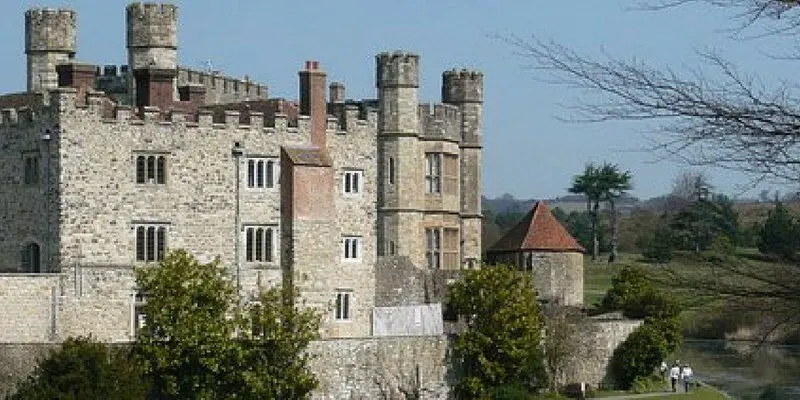Domesday Book Until Now
Leeds Castle has been a Norman stronghold; the private property of six of England’s medieval queens; a palace used by Henry VIII and his first wife Catherine of Aragon; a Jacobean country house; a Georgian mansion; an elegant early 20th century retreat for the influential and famous; and in the 21st century, it has become one of the most visited historic buildings in Britain.
The first historical record of the Castle is in the Domesday Survey of 1086, where the ‘Manor of Esledes’ was under the ownership of Odo the Bishop of Bayeux, who was also the half-brother of William the Conqueror.
In 1119 the first stone buildings were erected and they took advantage of the natural rocky outcrops that formed two islands in the River Len. Only a few architectural features survive from the 12th century building phase, such as the two-light window at the end of the banqueting hall and the cellar beneath the Heraldry room.
Six Queens of England
When Eleanor of Castile bought Leeds Castle in 1278 it began both the long royal ownership of the Castle and its association with six Queens of England. Many alterations and improvements had to be made during this period.
The Royals that succeeded Queen Eleanor were as follows: King Edward I, Queen Margaret of France, King Edward II, Queen Isabella, King Edward III, King Richard II and Queen Anne of Bohemia, Queen Joan of Navarre, and Queen Catherine de Valois.
Her grandson by her second marriage was Henry Tudor, who in 1485 became Henry VII, the first of the Tudor dynasty. Whilst King Henry VII never took an interest in Leeds Castle, his son King Henry VIII transformed it from a fortified stronghold to a magnificent royal palace.
Henry VIII
Between 1517-1523 on his orders, major alterations were made so that he and his first wife Catherine of Aragon, could visit the castle in comfort. In 1552, after nearly 300 years of royal ownership, Leeds Castle was given to Anthony St. Leger by Edward VI in recognition for his services to Henry VIII in subjugating the uprising in Ireland.
The end of the Tudor dynasty marked the beginning of private ownership for Leeds Castle. With no royal treasury to use for repairs and alterations, the fortunes of the Castle relied solely on the fortunes of the owners, which were varied.
In 1632 Leeds Castle was sold to to Sir Thomas Culpeper, whose son Cheney was a supporter of Parliament. Therefore, unlike many aristocratic homes, the Castle was left relatively unscathed during the Civil War, but at the Restoration in 1660 the Culpepers were in financial ruin.
Link with America
Despite this, the Culpeper family managed to retain the Castle and estate by selling it in 1663 to a wealthy cousin, another Sir Thomas Culpeper, who as a Royalist had the reward of five million acres of land in Virginia. This established the Castle’s link with America, a connection that has had a significant influence to this day.
Fire
Leeds Castle suffered major damage in 1665 when Culpeper leased the castle to the government. It was in use as a place of detention for Dutch prisoners of war. Lodged in the Gloriette, the prisoners set fire to their accommodation. Thereby causing destruction which would not be repaired until the 19th century.
In 1881, a survey of the castle’s condition was undertaken and its results were devastating. The mill and barbican were in ruins. The gatehouse and inner gatehouse in disrepair. In addition the Maiden’s Tower was in imminent danger of collapse. Also, the main Jacobean house was decaying and the Gloriette was more or less a ruin.
The New Castle
Wykeham Martin decided to demolish the main house and replace it with one in the Tudor style. The resulting New Castle, externally of little change to today, was complete by 1823, an extraordinarily swift process. By 1925, it was one hundred years after Wykeham Martin’s restoration and rebuilding. As a result the family had to sell the property to pay death duties.
It was acquired by the Anglo-American heiress the Hon. Olive Paget, then Mrs Wilson-Filmer, who was looking for a country retreat in Kent. She saw the castle’s potential. She had the style, imagination and funds to carry out the necessary modifications.
Lady Baillie
Lady Baillie, as she was to become after her third marriage, decided to recreate a largely medieval castle and initially commissioned architect Owen Little. It was he who created a glorious gothic fantasy for her. During the 1930s, Leeds Castle became one of the great country houses of England and a centre of lavish hospitality. It was the place to head for leading statesmen, European royalty and also film stars.
WWII
During World War II, the new castle was in use as a hospital. Many of the ill-fated expeditionary forces repatriated after the retreat from Dunkirk were treated at Leeds Castle. Lady Baillie died in 1974. Subsequently, she left the castle and grounds to a specially created charity called the Leeds Castle Foundation. The main aim was, and still is, to preserve the castle for future generations to enjoy.
To visit the Leeds Castle website, click here. Have you paid a visit to Leeds Castle? We’d love to know more! What was the most memorable part of your visit?
Find out if we have a coat of arms and surname history for your name by clicking here.



